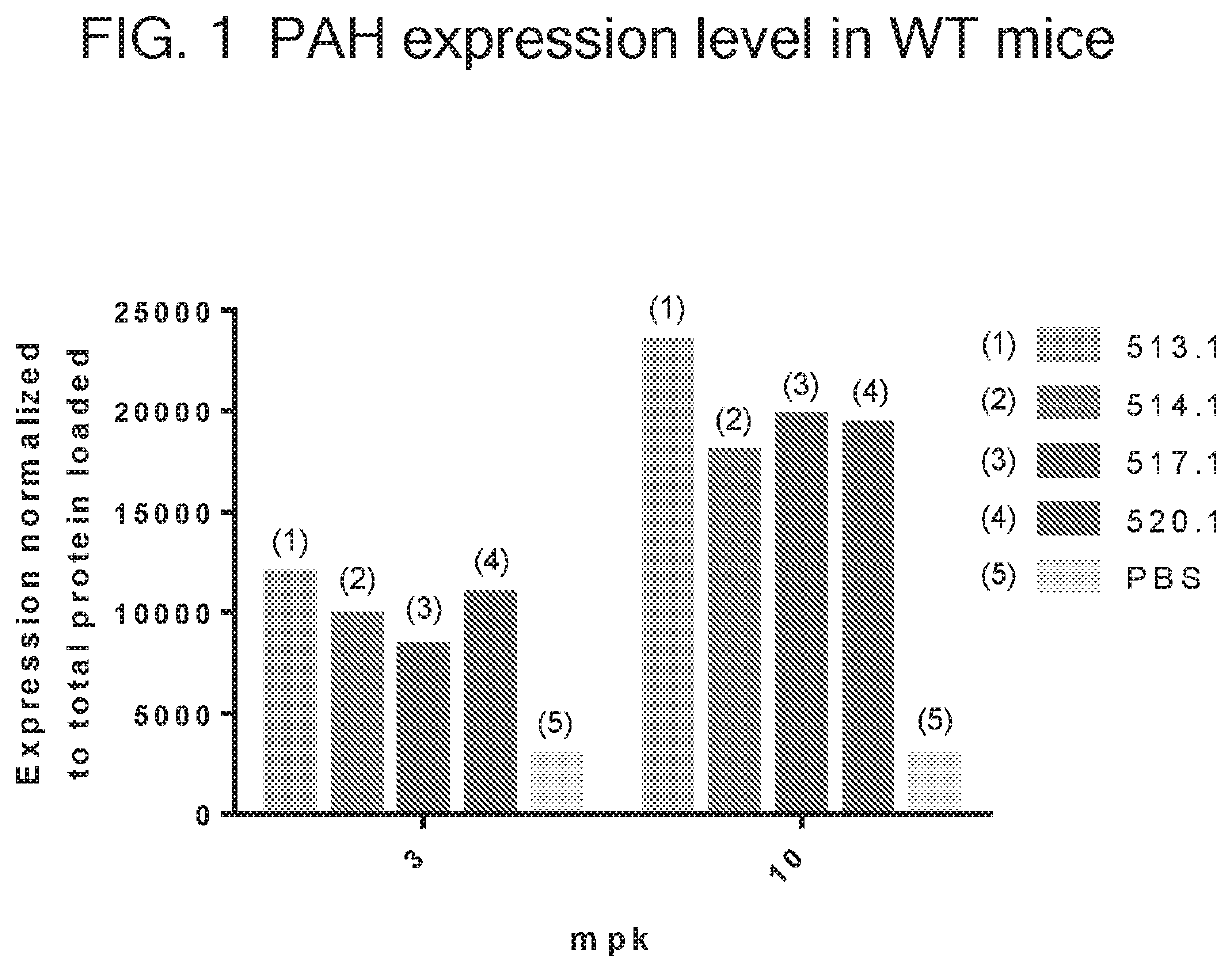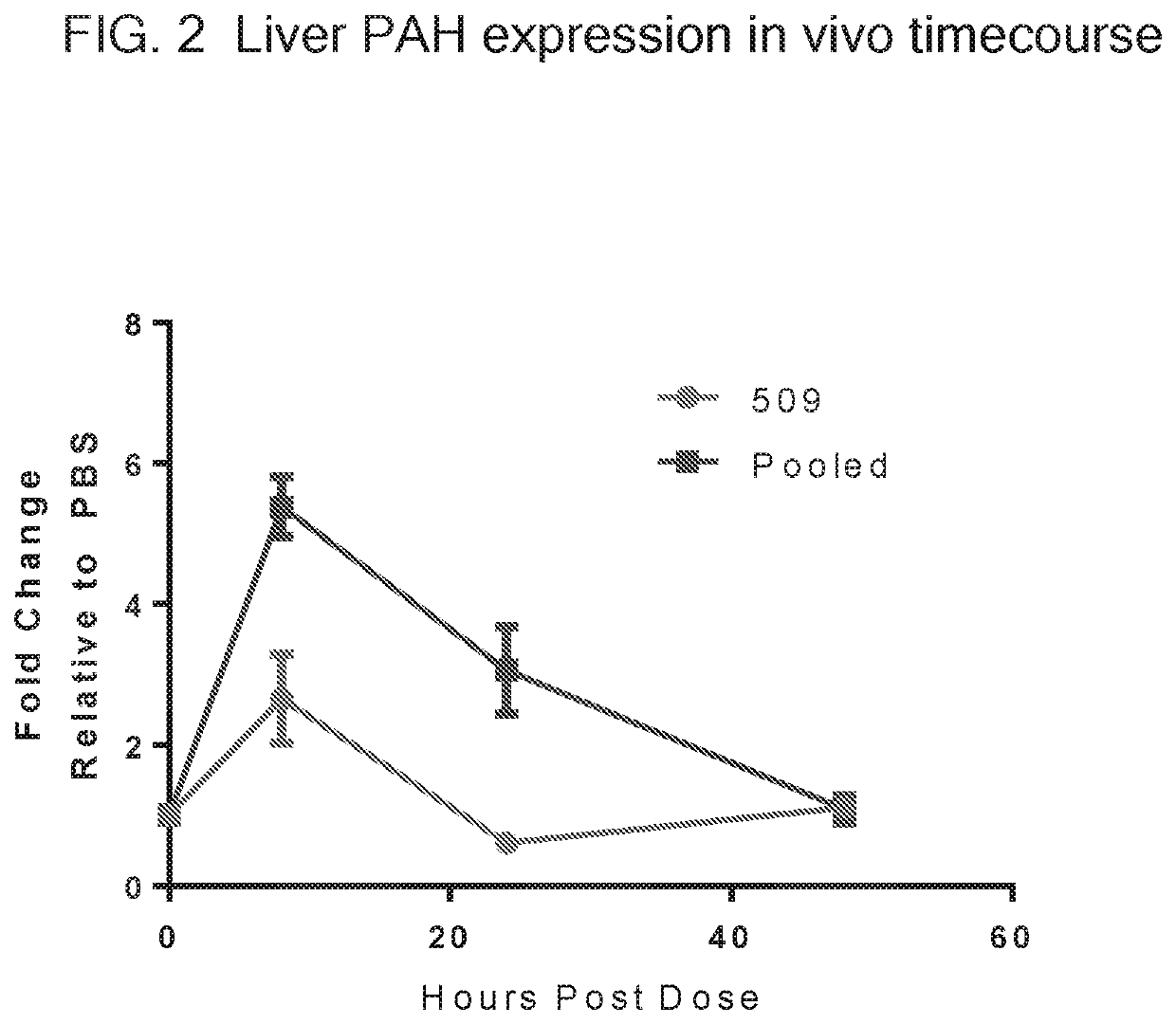Therapeutics for phenylketonuria
a technology of phenylketonuria and therapeutics, applied in the field of molecular biology and genetics, to achieve the effects of increasing activity, increasing cytoplasmic half-life, and increasing functional cellular activity
- Summary
- Abstract
- Description
- Claims
- Application Information
AI Technical Summary
Benefits of technology
Problems solved by technology
Method used
Image
Examples
example 1
Translatable Molecule 509
[0309]In this example, a reference translatable molecule 509 was made and used for expressing human WT phenylalanine hydroxylase (PAH). The translatable molecule comprised a 5′ cap (7mGpppG), a 5′ UTR of TEV, a Kozak sequence, a WT PAH CDS, a 3′UTR of Xenopus beta-globin, and a Poly(A) tail region consisting of 100 As (i.e., “Poly(A) 100 tail region”). The reference translatable molecule further comprised the sequence of SEQ ID NO: 44 immediately downstream of the PAH CDS.
[0310]Details of the structure of this reference translatable molecule are as follows: Tobacco Etch Virus (TEV) 5′ UTR of SEQ ID NO: 3, a Kozak Sequence of SEQ ID NO: 4, a WT PAH CDS mRNA sequence of SEQ ID NO: 5, a Xenopus beta-globin (XBG) 3′ UTR of SEQ ID NO: 6, and a Poly(A) 100 Tail of SEQ ID NO: 7.
[0311]Translatable molecules in the examples below can be synthesized with the 5′ cap being a m7GpppGm cap. The translatable molecules in the examples below can contain a 5′-UTR (e.g., a 5′ ...
example 2
ble Molecules Encoding PAH
[0312]In this example, a translatable molecules 510-521, 690-692, 694-707, 1778, 1971, and 1986 were made and used for expressing human phenylalanine hydroxylase (PAH) with advantageously increased efficiency of translation. The translatable molecules expressing human phenylalanine hydroxylase (PAH) exhibited activity suitable for use in methods for ameliorating or treating PKU. The translatable molecules comprised a 5′ cap (m7GpppGm), a 5′ UTR of TEV, a Kozak sequence, a PAH CDS, and a 3′ UTR of Xenopus beta-globin. Translatable molecules 510-511, 513-519, 690-692, and 695 further comprise a Poly(A) 100 tail region, while translatable molecules 512, 520-521, 694, 696-707, 1778, 1971, and 1986 further comprise a Poly(A) 114 tail region. The translatable molecules further comprised the sequence of SEQ ID NO: 44 immediately downstream of the PAH CDS.
[0313]The PAH CDS in each of the translatable molecules is comprised of the following sequences:
MoleculePAH CDS...
example 4
ssion in Human Primary Hepatocytes
[0326]In this example, human primary hepatocytes were transfected with codon-optimized mRNA. PAH protein expression was measured by flow cytometry at 24 and 72 hours post-transfection. The expression of ten codon-optimized mRNA sequences is shown in FIG. 6. Translatable molecules 1896.1, 1897.1, 1988.1, 1989.1, 1990.1, 1991.1, 1998.1, and 1999.1 illustrated in FIG. 6 are identical to translatable molecule 1778 with the exception of alternative 3′ UTR structures.
PUM
| Property | Measurement | Unit |
|---|---|---|
| size | aaaaa | aaaaa |
| pH | aaaaa | aaaaa |
| pKa | aaaaa | aaaaa |
Abstract
Description
Claims
Application Information
 Login to View More
Login to View More - R&D
- Intellectual Property
- Life Sciences
- Materials
- Tech Scout
- Unparalleled Data Quality
- Higher Quality Content
- 60% Fewer Hallucinations
Browse by: Latest US Patents, China's latest patents, Technical Efficacy Thesaurus, Application Domain, Technology Topic, Popular Technical Reports.
© 2025 PatSnap. All rights reserved.Legal|Privacy policy|Modern Slavery Act Transparency Statement|Sitemap|About US| Contact US: help@patsnap.com



